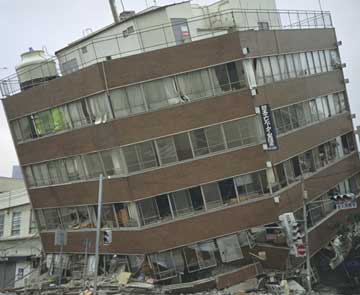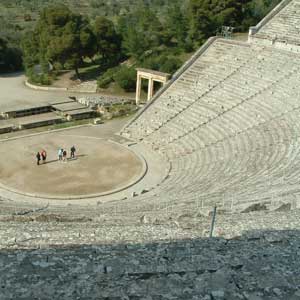|
NEWS NOTES — GEOPHENOMENA
Self-healing home may resist earthquakes
Rocks ring true at Epidaurus
 Roger Hutchison |
| Engineers are designing a house to withstand destructive temblors like the one that rocked 192,000 structures (including this office building) in Kobe, Japan, in 1995. |
Home, heal thyself: Using nanotechnology, scientists are designing a high-tech house that may be able to fight back against earthquake-induced damage by mending cracks in its own walls. The home — a villa to be built on a Greek mountainside — will include a specially designed polymer in its walls that can flow into fractures and harden, as well as an array of wireless sensors that can warn its residents of impending life-threatening damage.
Most buildings suffer structural damage during an earthquake because of sudden ground motion: Shifting along the fault line releases energy as seismic waves that travel for great distances through the ground. The interaction and interference of different seismic waves that causes this ground movement shakes buildings in a variety of ways.
Scientists have experimented with many ways to strengthen buildings against this motion, including the use of elastic materials that won’t break when shaken violently. Further protection from devastation will be in the building’s base, which will isolate the home’s movement from the ground’s and add shock absorbers to dissipate energy and minimize vibration.
But scientists at the Nano-Manufacturing Institute at the University of Leeds in the United Kingdom, collaborating with German manufacturing company Knauf and 25 other partners, have taken earthquake engineering several steps further. The new villa incorporates not only earthquake-resistant, load-bearing steel frames and high-strength gypsum walls, but its walls also contain a fluid containing a nano-scale polymer that scientists hope will help shore up its defenses. The polymer, added in tiny amounts to the gypsum walls, becomes liquid when squeezed under pressure. When cracks form in the walls as a result of the same pressures, the nano-polymer fluid then flows into them and hardens, sealing the fractures.
The structure will also include a network of wireless sensors that will record vibrations and stresses on the house’s structure and monitor temperature, humidity and gas levels. These data can be used to alert residents to serious danger and give them crucial time to escape. If the building does collapse, scientists say the structure will also have built-in radio frequency identity tags — transponders that can transmit information and help scientists pinpoint exactly what went wrong. At a cost of $19 million, the European Union is funding the construction of the self-healing home, which is projected to be completed in December 2010.
Earthquake engineering “is the kind of target that makes sense” for nano-technology, says Scott White, a mechanical engineer and project leader of the Autonomic Healing Research group at the University of Illinois at Urbana-Champaign. However, he adds, “There are many steps along the way to achieving something that works well.” For one thing, self-healing materials are so new that little is known about their long-term stability, he says. The Leeds group is still developing its nano-polymers and has not yet published data on their stability. Still, using self-healing systems for earthquake engineering may be a good fit, White says. “There’s great motivation to target a problem like that.”
 Courtesy of Nico Declercq |
| New research about the ancient Greek theater at Epidaurus indicates that the limestone seats may allow sounds on stage to carry all the way to the back row. |
Rather than to rock music, the amazing sound at the ancient theater at Epidaurus may be owed to the actual rock used in its construction — limestone.
Ever since the ancient Greeks built the limestone theater on the Peloponnesian Peninsula some 2,400 years ago, people have been wondering why its acoustics are so good that even whispers on stage can be heard in the 55th row. Some suggested that the sound was carried by wind, that performers wore special masks to amplify sound, or that the ancient Greek rhythm of speech somehow translated to good acoustics. But over time, each hypothesis has been discounted: Acoustics are just as good when there is no wind or when the wind is blowing in any direction, and current performers can be heard just as well as ancient performers, without the assistance of masks or rhythmic Greek language.
In modern times, some researchers have also postulated that the slope of the theater had something to do with the quality of sound, says Nico Declercq, an acoustics and ultrasonics expert at Georgia Institute of Technology at Metz, France, and lead author on a new study on the acoustics at Epidaurus in the Journal of the Acoustical Society of America in April. But that is not the entire story, he says. New mathematical models suggest that while the slope plays a part in the theater’s acoustics, the limestone seats play a larger role. They may be dampening background noise while amplifying the higher frequencies of human voices, Declercq says.
“I was absolutely sure that the limestone seats would have an effect [on the acoustics], but I had no idea if they would have a constructive influence or not,” Declercq says. At first, he thought that the limestone seats would confine the sound “very close to the seats” instead of allowing the sound to simply reflect back into space. The seats indeed do that, he says, but numerical results suggest that the bigger factor is that the limestone essentially “filtered out” frequencies lower than 500 hertz — largely “background noise,” such as wind and crowds rustling.
Declercq has observed a similar process at a few other sites, such as Chichen Itza in Mexico’s Yucatan Peninsula. The ancient Maya pyramid structure at Chichen Itza is known for its remarkable acoustics, especially its “quetzal echo,” which can be heard when the pyramid structure reflects the sound of a hand clap or voice in the tone of a chirp from the sacred quetzal bird.
“I’d say he is probably on the right track,” says Mack Breazeale, a physicist at the National Center for Physical Acoustics at the University of Mississippi. Several years ago, Breazeale showed that sound waves can be propagated backward along a surface and reradiated to boost acoustics, he says. Declercq and co-author Cindy Dekeyser, also of Georgia Tech, applied this idea to Epidaurus, Breazeale says, to determine at which angles the seats maximized the acoustics. When placed at the correct angle and spacing, corrugated surfaces — such as these rough-hewn seats — carry the sound best, he says.
The mystery of Epidaurus has lasted for 2,400 years, Declercq says. Though the Greeks and Romans recognized that the acoustics at Epidaurus were superior, historical writings suggest that they didn’t know why, and therefore they were unable to recreate the perfect conditions over the centuries, he says. Evidently, they just needed some good rock.

 Subscribe
Subscribe


